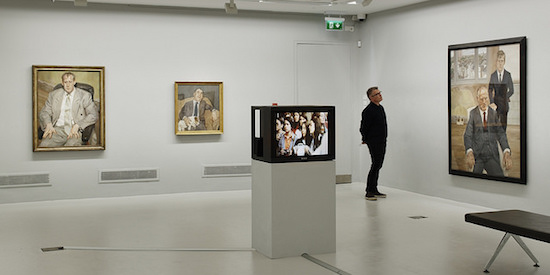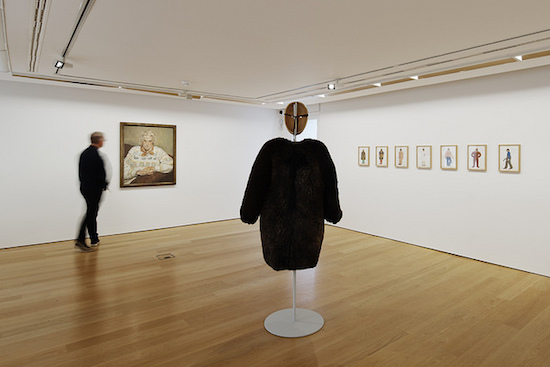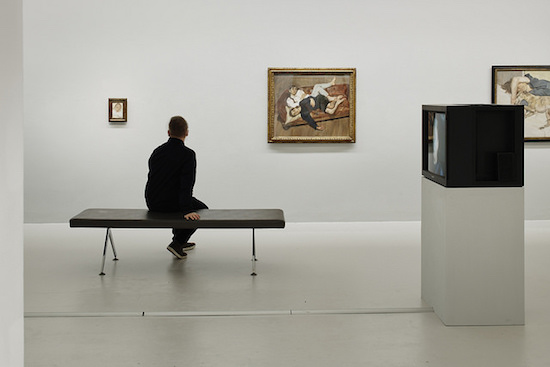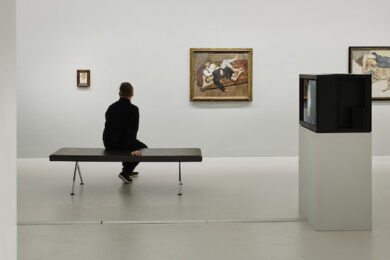All images: IMMA Collection: Freud Project, The Ethics of Scrutiny, Curated by Daphne Wright, Irish Museum of Modern Art, Dublin. Photography Ros Kavanagh
The Ethics of Scrutiny curated by artist Daphne Wright places original works and reproductions side by sde to look, think and learn from each other. As part of the IMMA Collection: Freud Project, a five-year initiative that encourages new thinking around a collection of fifty works, The Ethics of Scrutiny is an active exploration of Lucian Freud’s hypersensitive gaze, what it longs to record and what is left after it has passed. Freud’s practice is placed alongside works that articulate the complexity of human lives and their entanglements, watercolours by Marlene Dumas, a portrait by Alice Neel, the Maskenkostüme’s of Wiebke Siem and sculptural works of Kathy Prendergast and Thomas Schütte. The voice is present also in the inclusion of works by John Berger, Bernie Brennan, Lydia Davis, Emily Dickinson and Ottoline Leyser placed within rooms in the exhibition to create a space for truths to be articulated.
You begin the exhibition with four observational watercolours by Sigmund Freud. These works are a record of the dissection of hundreds of eels in an attempt to chart their male reproductive organs. The watercolours introduce layers of meaning. They articulate a juncture at which one professional journey is made and not another, why the dismantling of a form can result in its annihilation and how failure always leads to the unexpected (here the glut of anguilliformes contributed to vital research in the future on nervous tissue and the neuron). The works prompt questions on genealogy and the residue we carry of the skills of our forebears. Alongside Freud are reproductions of Emily Dickinson’s Envelope Poems presented in a vitrine, manipulations of the page in which both paper and language are unfolded and examined with charged force. The poems which were long considered as notes are now recognised to be fully realised works that study the materiality and malleability of the word. One painting by Lucien Freud is present in the room, Annabel, a corporeal study painted in 1990, the force of its analysis of its subject is revealed through association.
The journey into the next room is unexpected, it is dark and full of the sounds of visitors to a public gallery, hung next to the door is Gwen John’s Self Portrait, Nude Sketching which holds the sense of a reflective space as present as those in an Instagram feed. The soundtrack of the crowd ebbs and flows and gives voice to the early twentieth century paintings Nude Girl and Interior that are filmed in 16mm from reproductions and projected to the actual scale of the original paintings. These works glow with the intensity of mobile phone screens, public and private space, self-reflection and self-knowledge present in how the works of John’s look back out at us. The sound of the cameras recording merges with that of the crowd, the works prompt reminders of how there has been a continuum in the citation of Gwen John’s painting as an act of resilience present since their reproduction on the front covers Virago Modern Classics. As with Freud’s own practice, John’s paintings gained a great visibility through its use in the world as an image cropped and recontextualised. In Wright’s use of these works they are reanimated and knowing.
The exhibition is a series of nodes. As you pass by Lucian Freud’s Head of a Girl placed in a small connecting corridor into the next room the voice of James Salter is reading Lydia Davis’ short story ‘Break It Down’. The sound projected from a single speaker placed facing the audience is hard not to anthropomorphise into a human portrait. ‘Break It Down’ charts the cost of a fleeting infatuation, and its dwindling from the rush of declarations of love into the body of the other, into the space in which their absence is dulled into the occasional moments of regret. Sharing this space is Marlene Dumas’ watercolour Kissing the Floor, an echo of the moment that Janet Leigh’s face hits the tiles as she falls dead in Hitchcock’s Psycho. The experiences of control and infatuation that Grace Kelly, Vera Miles, Kim Novak, Janet Leigh, and Tippi Hedren encountered from Hitchcock are present here without needing to be stated.
In the basement is an installation of paintings that chart the themes and subjects that focussed Freud. Critic Christopher Bramham is caught in thought near a painting of a filly in a stable and a dead bat tangled in weeds on the ground. The singular individual is placed in the context of collective portraits, clustered together in the constraints of the studio are the Pearce Family, Freud’s daughter Rose Boyt and her husband Mark Pearce, with them their two children. There is a slippage in time here, the duration of the painting capturing both Rose’s pregnancy and second child seated on their father’s knee. On the opposite wall is the formal father and son of Two Irishmen in W11, both suited, the father seated with the son standing with his hand placed on his shoulder. If you look round at the facing wall, a portrait of the son looks back over at it. These disparate subjects coalesce; the woman in repose with a sleeping dog, the garden, the sitter, the artist, the corporeal, and the studio. Painted over the decades they overlap in Wright’s installation and are set into context with two monitors that face each other each screening a segment from John Berger’s BBC television series Ways of Seeing, the viewer seated on a bench between them.

Episode Two of Berger’s Ways of Seeing contains a rupture that is captured by Wright.
It begins with an ominous drone, over which a kaleidoscope of feminine roles is played: models at a beauty photo-shoot, painted nudes and arrivals of actresses at previews and functions. A visual outlining of the gaze. This section of footage undercut with Berger’s pronouncement “Men dream of women, women dream of themselves being dreamt of”.
The words “how she appears to men is of crucial importance for what is normally thought of as the success of her life”, as stingingly relevant now as they were then. As this monitor switches off, on the other screens in the room, a group of women invited by Berger to discuss the nude relay their lived experience of these dreams of female representation. They talk as though they will never be listened to again. There is little for Berger to do other than to smoke, drink and listen. The inclusion of Ways of Seeing brings with it the criticality present at the time Freud’s paintings were made, the ways in which pre-digital media disseminated and reproduced the singular image. There is an oddity in the women’s discussion of representations of the female body: how it infects the works in the room, it pulls everything in and talks directly of dissent.
There are other presences, a Begonia cultivated by a plant kept by Sigmund Freud is placed on a shelf as a listener to biologist Ottoline Leyser’s discussion on the transgenerational epigenetics of plant life. Leyser outlines how the survival of generations is informed by experiences of hardship and scarcity a statement that cannot lie dormant in a room of works informed by enforced migration. Placed also within this room are clear family dynamics: an early Lucian Freud self-portrait, full of anxious energy, faces The Painters Mother Resting, a work made later in life at a time of vulnerability and familial crisis. Present also is Small Bouquet 2, a cast by Kathy Prendergast of the dried wedding bouquet from her parents wedding, a sculpture that makes evident the bonds and ties that are present between generations.

In the concluding room of the exhibition is placed a sculpture from Thomas Schütte’s Trio series, men tied together, in furious response to their own fragility and mortality, this work staged with Lucian Freud’s Reflection (Self Portrait) painted in 1985. The emotional weight of the painting vocalised through the inclusion of a recording of Bernie Brennan singing ‘Hurt’, Trent Reznor’s song of consequence and regret. An American Gothic that was landed with such grace by Johnny Cash to reflect on what remains of his life prior to his death. Brennan’s voice filled with lived experience lands the lyrics “You are someone else. I am still right here” with an honesty that winds you. There is an interaction between these works which encourages the gaze to turn inwards on itself, we are left looking at the portrait of Freud as though it is a mimetic mirror, one in which we believe we can perceive the vulnerability and self-awareness of the author.
The Ethics of Scrutiny is charged with latent potential, each room is a proposition on causation that Wright should take further. Like Duchamp’s Boîte-en-valise this exhibition contains practices that are renewed and enriched through proximity. Wright’s skill as an artist is present in her use of the human voice to fill the space that would be otherwise unarticulated, to reveal moments of mood, clarity and realisation. To present the work of Freud within these conversations is a renewal of his practice, that relates work that has long described as timeless to be open to both the near past and present without reserve.
The The Ethics of Scrutiny is at IMMA Freud Centre until 2 September. The IMMA Collection Freud Project will present curated shows and projects on the collection until 2021 at the Irish Museum of Modern Art



